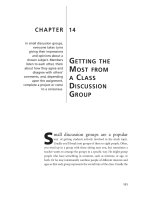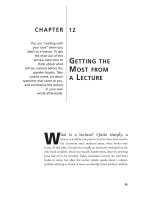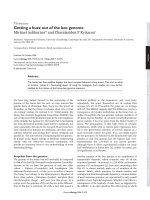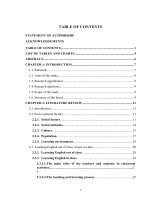GETTING THE MOST OUT OF CLASS
Bạn đang xem bản rút gọn của tài liệu. Xem và tải ngay bản đầy đủ của tài liệu tại đây (94.24 KB, 12 trang )
Getting the Most Out of Class
89
Secret 7
G
ETTING THE
M
OST
O
UT OF
C
LASS
E
leni knew she was shy, but she felt it was simply
something she would have to live with.
The problem was that her shyness was interfering with
her favorite class—geometry. Eleni envied her class-
mates who could throw up their hands during class or
hang around after class to ask Ms. Hartick a question.
The tricks Eleni relied on for her other classes were not
working. She couldn’t ask for help from a friend because
she had no friends taking geometry. She couldn’t find
answers to some questions by studying her textbook
because she didn’t understand some of the textbook’s
explanations. When Ms. Hartick was discussing a new
concept or reviewing a difficult problem, Eleni needed an
explanation on the spot.
Eleni explained her problem to her boyfriend and was
surprised by his response. “I bet other people have the
same question you do,” Alberto said. “You’d be doing
them a favor by asking your question.”
The next day, Eleni gathered her courage and raised
her hand. Ms. Hartick seemed pleased, and her answer
prepared Eleni for the rest of that day’s material.
When class was over, Ms. Hartick approached Eleni
and said, “Welcome to class.”
Some students work extra hard to get the most they can out of their
classes. Eleni went as far as to work against her own nature—being
shy—to understand geometry better. Two unforeseen benefits of
Eleni’s question asking are:
•
helping other students who had the same questions
•
having a closer relationship with Ms. Hartick
Do you hesitate to ask questions because you are shy or because you
think you will appear stupid? Do you know how to listen to a lecture?
Stay tuned, because this chapter offers multiple techniques for listen-
ing and questioning, as well as for working with study groups and
study pals.
LISTENING TO A LECTURE
What is a lecture? A lecture is a talk given by one person. Lectures have
been used in the classroom since medieval times, when books were
scarce. At that time, a lecture (French for reading) was usually an instruc-
tor reading from the only book available, which was handwritten
because the printing press had yet to be invented. Today, lectures are
sometimes read from books or notes, but often the teacher simply speaks
about a subject, perhaps referring to a book or notes occasionally.
Your job as a student in a lecture situation is to be an active listener.
You want to become involved with what you are hearing. This takes
four steps:
1. absorbing information
2. analyzing what is important to remember or to study later
3. organizing ideas
4. writing down or drawing the information for future study
Steps 2, 3, and 4 may come in a different order, depending on your lis-
tening and learning styles (See Secret #5).
Listening Styles
If you learn best by hearing, you might find that taking notes while you
listen distracts you from what you are hearing. To test this, listen to a
90
10 SECRETS TO ACING ANY HIGH SCHOOL TEST
talk show without taking notes; then, on another day, listen to a talk
show while taking notes. Decide which works better for you. Either
way, writing down questions that come to mind—or even key words
that will help you recall information—might be helpful.
If you learn best with images, you need to “see” what you are listening
to. Doodle or draw pictures, maps, or timelines of what the lecturer is
talking about. Use different colored markers to highlight your notes.
If you learn best by using order, you will want to feel a clear order of
events while you listen. Make lists and timelines of what the lecturer
is saying. Outline the lecture or number points in the margins.
If you learn best by doing and moving, you need the sense that you are
experiencing what is being talked about. Try different ways of doing
this. For doing, you could pretend you are a reporter for a magazine
on the subject of the lecture, and you need to take careful notes so
your readers will have an accurate understanding of the subject. For
moving, you might find that you stay focused best by writing down
every word or by gently tapping your foot to the rhythm of the lec-
turer’s speech. (Just don’t disturb others around you!)
Translating What You Hear into Useful Notes
Depending on the teaching skills of your instructor, you may need to
work harder at understanding what he or she has to say and translat-
ing his or her words into useful notes. Here are three strategies that
instructors use to organize their lectures. Use the same strategies to
help you organize your notes:
•
beginning—middle—end
•
past—present—future
•
theme—sub-theme
Some instructors put a lot of stories, jokes, or irrelevant material into
their lectures. Do not include this extraneous material in your notes,
unless it helps you to remember a point. For example: “Organic com-
pounds always contain carbon (pasta carbonara story).” Discover
more about memory tricks in Secret #9.
Asking for Help
What if you listen and take notes but still have questions? Whom can
you ask for help?
Getting the Most Out of Class
91
•
your teacher (during class, after class, or during tutoring hours)
•
your lab partner or study buddy (more on this later in the chapter)
•
a member of the class who seems to “get it”
•
the class aide or student teacher
•
your study group (more on this later in the chapter)
If you don’t understand a concept, get help as soon as you can. It is
best not to wait until the last minute to get help—your teacher may
not be available to you. This is especially important in science or
math, where each new lesson is often built upon the previous one.
If you need to meet with a teacher or an aide for extra help, try to
prepare specific questions first. You are more likely to get clear, spe-
cific answers.
To help her through her Spanish class, Laurie’s mom hired a tutor,
who is a Spanish major at a nearby college. Laurie had heard two
interesting facts about tutors:
1. Hiring a competent tutor for 25% of the course content is as good
as hiring one for 100% of the course. Why do you think this is?
Answer: If you worked with a competent tutor for the first 25% of
the course, he or she could help you understand the basic, underly-
ing concepts of the subject, for example, how to write proofs for
Algebra II. Also, any good tutor would help you organize and pri-
oritize the subject you are studying—skills you could apply to the
remaining 75% of the course.
2. A good tutor’s grades go up along with the grades of the person
being tutored. Why do you think this is?
Answer: Teaching something to someone else is one of the surest
ways to judge what you know and don’t know, what you remember
and don’t remember, and if you know how to paraphrase (restate in
your own words) what you have learned. This is why peer tutoring
programs are so successful.
STUDY BUDDIES
In any class, it is valuable to get the phone numbers of at least two of
your classmates. That way, if you get sick or miss class, you will have
fellow students to call to find out what you missed. They may let you
92
10 SECRETS TO ACING ANY HIGH SCHOOL TEST
copy their notes or their audiotapes of a lecture. If you want to study
together or check information—even if it’s over the phone—you will
have potential study buddies.
At one time or another, everyone has dreaded the idea of studying
for a particular exam because the topic was extremely difficult or
painfully boring. In such instances, studying with a partner might be
the best approach. Studying with someone else is often easier and
more enjoyable. The partner, or study buddy, can be a classmate,
friend, coworker, or family member.
If your study buddy is studying the same topic you are, you can
work as a team in developing questions and finding the answers. If
your buddy is someone from outside class or work, she can act as your
student as you teach her what you have been studying. She can also
act as your coach by asking you such questions as, “What part of this
interested you most? Why? What sticks out in your mind?”
SOURCES IN CYBERSP
SOURCES IN CYBERSP
ACE
ACE
Study Groups
These sites provide tips on forming and running your study group:
•
www4.rmwc.edu/tutor/form_a_study_group.htm
•
homeworktips.about.com/library/weekly/aa112099.htm
•
www.fieldbook.com/Study_groups/studygroupsHow.html
•
www.willamette.edu/cla/ler/studygroups.htm
Working with a Study Buddy
By making yourself understood, listening carefully, and working with
your learning style and that of your partner, you will get more out of
studying with a study pal. And you will have more fun, too!
You will probably feel a lot less pressure in school if you have some-
one to work with. When you work with a partner, you have someone
to bounce ideas off of, discuss things with, and ask questions of. Here’s
how a study buddy can help:
• If you are working on the same problem, one of you might know
the answer and can help the other; if neither of you knows it, you
can figure it out together.
Getting the Most Out of Class
93









